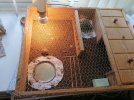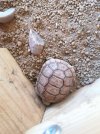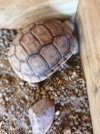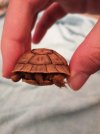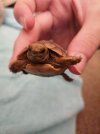Geralt
New Member
I've ended up in a confusing predicament housing 2 baby desert tortoises in the UK. It's a complicated story how we ended up with them and how they got here in the first place but we have no idea how to care for them and are trying our best to research and look into caring for them as they grow.
I hope someone can offer some guidance or suggestions as what action to take for them. I'll try outline our equipment and procedures.
We have 2 desert tortoises, 1 male and another is female, which I've heard is problematic. However, we do not have space for a desperate enclosure atm.
They are very small, Idk how old and we have bought a roughly 34" by 30" enclosure for them with a heat lamp, a water bowl and a place to eat. One side of the enclosure is hovering over a radiator that gets that side warm while the other side can be cooler. We try to keep the heating in the house to keep them warm as often as we can.
For UV we try to let them gain natural sunlight when it is sunny for about 20-30mins. It's not that hot and it can be windy so we hold them near an open window and shield them from the wind and let them gain some sunlight, occasionally holding them near a radiator to warm them up if they become too cold. It's clearly very clunky and time consuming since I have no other way to allow them to gain sunlight in the cold temperatures atm.
We have a water bowl they can climb into and cook down or drink from when needs, but I try to put them in water myself once a day. I don't know how necessary this is, but I do it just incase.
Their diet consists more recently of weeds in our garden that they like, we wash and prepare them and they enjoy nibbling away at them. Atm we haven't had much variety so it's been a few veggies mixed in with weeds and grasses. Carrots, lettuce and used to be cabbage until I found out it wasn't good for them in excess. Occasionally we give them small apple slices. I heard boiled egg shells are good for calcium however idk if this is appropriate for a baby??
I realise I will likely need to be more specific with my temperatures, humidity and substrate by investing in a heat gun etc. I've seen various opinions about heat lamps, but again I'm not entirely sure. I'm gonna attach some photos of our set up (it's not that elaborate).
Finally, tortoise health. Again I'm totally new and so this is all slightly overwhelming, these tortoises were practically dumped on us and so it's hard to get everything together and know everything. I'll take pictures of there shells incase anyone notices any health issues. Their shells look quite nice and I don't see any issues. There were a few bumps I could see on the shells, Idk if this is normal. Also, are there any issues I should look at for?
(the one in the corner is the female, the other is the male)
If anyone has any other advice if suggestions please feel free to offer them. I'm not sure if what I'm doing is correct or sustainable for them. Particularly for when they get older too, it's the UK and it's certainly not hot. What should I do when indoor enclosure is no longer feasible?
I hope someone can offer some guidance or suggestions as what action to take for them. I'll try outline our equipment and procedures.
We have 2 desert tortoises, 1 male and another is female, which I've heard is problematic. However, we do not have space for a desperate enclosure atm.
They are very small, Idk how old and we have bought a roughly 34" by 30" enclosure for them with a heat lamp, a water bowl and a place to eat. One side of the enclosure is hovering over a radiator that gets that side warm while the other side can be cooler. We try to keep the heating in the house to keep them warm as often as we can.
For UV we try to let them gain natural sunlight when it is sunny for about 20-30mins. It's not that hot and it can be windy so we hold them near an open window and shield them from the wind and let them gain some sunlight, occasionally holding them near a radiator to warm them up if they become too cold. It's clearly very clunky and time consuming since I have no other way to allow them to gain sunlight in the cold temperatures atm.
We have a water bowl they can climb into and cook down or drink from when needs, but I try to put them in water myself once a day. I don't know how necessary this is, but I do it just incase.
Their diet consists more recently of weeds in our garden that they like, we wash and prepare them and they enjoy nibbling away at them. Atm we haven't had much variety so it's been a few veggies mixed in with weeds and grasses. Carrots, lettuce and used to be cabbage until I found out it wasn't good for them in excess. Occasionally we give them small apple slices. I heard boiled egg shells are good for calcium however idk if this is appropriate for a baby??
I realise I will likely need to be more specific with my temperatures, humidity and substrate by investing in a heat gun etc. I've seen various opinions about heat lamps, but again I'm not entirely sure. I'm gonna attach some photos of our set up (it's not that elaborate).
Finally, tortoise health. Again I'm totally new and so this is all slightly overwhelming, these tortoises were practically dumped on us and so it's hard to get everything together and know everything. I'll take pictures of there shells incase anyone notices any health issues. Their shells look quite nice and I don't see any issues. There were a few bumps I could see on the shells, Idk if this is normal. Also, are there any issues I should look at for?
(the one in the corner is the female, the other is the male)
If anyone has any other advice if suggestions please feel free to offer them. I'm not sure if what I'm doing is correct or sustainable for them. Particularly for when they get older too, it's the UK and it's certainly not hot. What should I do when indoor enclosure is no longer feasible?
